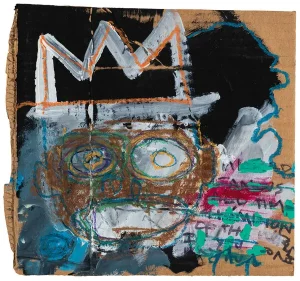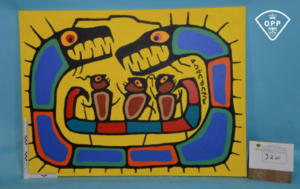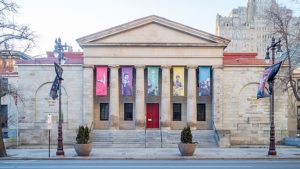These past few days, the art world has been abuzz with lawsuits, with those involved ranging from museums, auction houses, art schools, and proper criminals.
OMA Responds to Former Director’s Countersuit

Untitled (Self-Portrait or Crown Face II), one of the Basquiat forgeries seized from the Orlando Museum of Art
On Monday, June 3rd, the Orlando Museum of Art (OMA) finally responded to the countersuit brought against them by its former director, Aaron de Groft. OMA initially fired and sued De Groft after the FBI raided the museum during an exhibition featuring twenty-five newly discovered works by Jean-Michel Basquiat. The works were seized since they are likely all forgeries. Evidence suggests that De Groft probably knew that the Basquiats were fakes and that he had conspired with the paintings’ owners to get a cut of the profits from any future sale in exchange for the authentications. Though he denies it, De Groft has a history of making miraculous rediscoveries from which he has tried to profit. Despite filing his countersuit in November 2023, the museum has finally responded. In a recent court document, the museum states it “denies it committed any of the unlawful actions alleged in the Amended Counterclaim and denies De Groft is entitled to any of the relief sought”. The parties involved have opted for a jury trial scheduled for October 2025.
Lawsuit Brought Against Christie’s Over Cyberattack
On June 5th, two days after OMA responded to De Groft’s counterclaim, Christie’s was hit with a lawsuit over their handling of the cyberattack that forced them to shut down their website last month. We now know that the hacker group RansomHub launched a cyberattack against the auction house on May 9th, shortly before the May Marquee sales in New York. Consequently, the auction house shut down its website for ten days. The auctions continued as planned, with viewers able to watch via live stream on the Christie’s YouTube page instead of through Christie’s Live. RansomHub claimed responsibility for the attack on May 27th, and Christie’s emailed clients on May 30th explaining the situation. In the email, the company reassured clients that the attack had not compromised any financial data. This recent lawsuit alleges that while financial data was kept safe, personal information was still breached. It is estimated that the cyberattack compromised information on nearly 500,000 clients.
The lawsuit claims the cyberattack was made possible because of the “failure to implement adequate and reasonable cyber-security procedures and protocols necessary to protect consumers’ [personally identifiable information] from a foreseeable and preventable cyberattack”. While the lawsuit is a class action, the only member of the class now identified is Efsthathios Maroulis, a business executive based out of Dallas. The kind of data compromised in the cyber attack, known as personally identifiable information (PII), is a hot commodity on the dark web for identity theft. Maroulis has his own angle on the situation, though. The companies he’s involved with are primarily digital marketing, meaning that, to do his job, his company buys personal data from data brokers to craft targeted marketing for specific demographics. His lawsuit complains that the data of those affected by the cyberattack is now worth less than before, allowing more companies to purchase this data for marketing purposes. He is asking for damages, payment of legal fees, and a court order to force Christie’s to implement the necessary updates to better protect client information. Judge Jesse Furman of the Southern District of New York scheduled a pre-trial conference for September 10.
Another Guilty Plea in Morrisseau Forgery Trial
Other developments from the past week include the trial of a forgery ring that produced fakes in the style of the indigenous Canadian artist Norval Morrisseau. The group’s alleged leader, Gary Lamont, has already pleaded guilty in December to charges of forgery, making false statements, and defrauding the public. But now, another of the ringleaders has done the same. David Voss is the one who directly oversaw the production of the Morrisseau forgeries and has now pleaded guilty to the charges associated with his illicit activities. Efforts are still underway in identifying the hundreds of forgeries the group produced and sold. The Canadian Conservation Institute, however, has found that the best way to spot a fake is by scanning the work to see if there is a preliminary drawing in pencil beneath the paint. This is one of the best ways to determine that the painting was done by the forgery ring and not Morrisseau himself.
Case Dismissed in Van Gogh Restitution
With the Houston Museum of Fine Art winning its legal battle to keep a Nazi-looted Bernardo Bellotto painting, there was another defeat for restitution advocates this week. A federal court has dismissed a lawsuit brought by the descendants of the Mendelssohn-Bartholdy family against the Japanese company Sompo Holdings. Due to the pressures of Nazi Aryanization laws, the family, once some of the most prominent bankers in Germany, sold their art collection under duress, including the Van Gogh painting Vase with Fifteen Sunflowers. The family claims that when Sompo Holdings bought Sunflowers at auction in 1987, the company was fully aware of the painting’s problematic provenance yet went ahead with the purchase anyway. The painting has since been permanently displayed in Tokyo at Sompo’s museum. Despite this, the courts say that they have no jurisdiction in this matter. The Mendelssohn-Bartholdy family has not indicated if they will continue their legal battles in Japan.
UArts Closure Sparks Lawsuit
Finally, the most recent news: Philadelphia’s University of the Arts faces a lawsuit following its abrupt closure last week. Given the suspicious circumstances under which the school announced its closure, there were bound to be calls for an investigation. Appropriately, a class action lawsuit was brought against the school by nine employees, including professors and department heads. As I pointed out when I first covered the story, UArts’ choosing not to tell their staff and student body about the school shutting down until the last minute might get them into legal trouble. Specifically, a company with over one hundred employees is legally obligated to give their staff sixty days’ notice in advance of any mass layoffs or closures in accordance with the Worker Adjustment and Retraining Notification Act. The plaintiffs also accuse the school of withholding wages. Eric Lechtzin, an attorney representing the former staff members, described the school’s decisions as “incomprehensible”, and that the situation “reflects a complete failure of leadership”. On June 7, Pennsylvania Attorney General Michelle Henry announced her office would investigate the events surrounding UArts’s closure. Both the Philadelphia City Council and state lawmakers are organizing hearings, initiating investigations of their own through committees.


